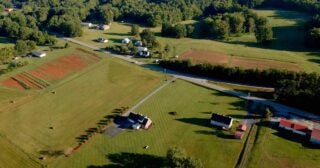- Resources
- Small North Carolina farms find profitability in climate resilience
Resources
Small North Carolina farms find profitability in climate resilience
Published: March 29, 2022 by Vincent Gauthier
Farms across North Carolina are experiencing more variable and extreme weather associated with climate change, including hotter nights and more frequent and severe rainfall. Small farms are adapting to these changes by adopting climate-resilient practices that help buffer weather extremes and improve soil health.
Measuring and communicating the financial costs and benefits of these practices is important to help more farmers adopt them profitably and find financial support for the transition. Cooperative extension agents — small farms’ closest technical advisers — will increasingly need to inform farmers about climate-resilient practices and their financial impacts.
Environmental Defense Fund and North Carolina Agricultural and Technical State University Cooperative Extension collaborated with three small North Carolina farms to measure the financial impacts of adopting reduced tillage, high tunnels and cover crops. The results are summarized in a new report and set of case studies.
New Ground Farm in Robeson County, Blackwell’s Farm in Rockingham County, and Against the Grain Farm in Watauga County provided in-depth financial data about the impact that climate-resilient practices had on their operations. Here are three takeaways from their experiences that farm advisers can share with the small farms they support.
Against the Grain Farm protects high-value crops from fluctuating mountain climate
Holly Whitesides is owner and farmer at Against the Grain Farm in the western mountains of North Carolina. The farm has been experiencing more frequent swings in drought and excessive rainfall that can damage crops.
Over the last few years, Holly decided to invest in high tunnels to allow the farm to grow high-value crops, including tomatoes, ginger and peppers. The high tunnels helped buffer temperature and precipitation fluctuations and lengthen the growing season.
The high tunnels increased the farm’s revenue by $17,000 per year. After offsetting the cost of purchasing and financing the two high tunnels, the benefits of the structure increased the farm’s net income by $13,000 per year.
New Ground Farm improves resilience to heavy rainfall with cover crops
Millard and Connie Locklear own and operate New Ground Farm, a nonprofit produce and education farm in North Carolina’s coastal plain. The Locklears face challenges from increasingly frequent hurricanes hitting their farm.
They have implemented reduced tillage and planted cover crops to reduce soil compaction and increase water filtration during heavy rain and hurricane events. Improved soil health has kept water from pooling in their fields and killing their crops.
Millard and Connie have tested different cover crop seed mixes over the last few years. This past year, they grew a diverse mix of spring peas, common vetch, crimson clover, spring oats, daikon radishes and seven other species that cost them $45 per acre. However, the cover crop seed, planting and machinery costs were offset by reduced fertilizer costs and weed suppression benefits that saved them $80 per acre. Overall, planting cover crops had no significant impact on the farm’s finances.
Blackwell’s Farm reduces erosion and saves costs by reducing tillage
Beverly Bowen is the proud co-owner and operator of Blackwell’s Farm in the Piedmont region of North Carolina. She raises beef cows and grows field crops and specialty greens on 60-acres of sloped grazing pastures and hilltop crop fields. Hurricanes and severe rains are hitting Beverly’s farm more often, challenging her fields’ ability to hold on to the topsoil.
Beverly adopted reduced tillage and cover crops in 2019 in response to these challenges. The practices have helped increase soil organic matter and water absorption capacity in her fields.
Reduced tillage practices decreased costs on the farm, saving almost $2,000 over 15 acres in reduced fuel, labor, fertilizer and erosion repair expenses. Even after additional costs of purchasing a new tractor and no-till equipment, reduced tillage increased the farm’s annual net income by more than $400.
The three farms participating in this study demonstrate that building resilience to more variable and extreme weather can also support farm profitability. Reduced tillage, high tunnels and cover crops contributed to buffering the impacts of weather fluctuations and temperature extremes. They provided these benefits while increasing revenue in some cases and reducing costs in others.
As climate change impacts continue to affect small farms, it will be critical for cooperative extension agents and other farm advisers to educate farmers about climate-resilient practices and their financial impacts to help farms stay profitable and productive in a changing climate.
Hear from the farmers
